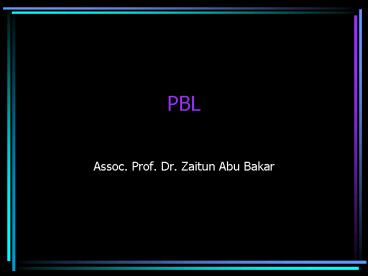PBL - PowerPoint PPT Presentation
1 / 24
Title:
PBL
Description:
Problem-based learning is a pedagogical strategy for posing significant, ... Bethel, Maine, USA. Self-directed. learning. Structured. learning. events. PBL. Activity ... – PowerPoint PPT presentation
Number of Views:34
Avg rating:3.0/5.0
Title: PBL
1
PBL
- Assoc. Prof. Dr. Zaitun Abu Bakar
2
What is PBL?
- Problem-based learning is a pedagogical strategy
for posing significant, contextualized, real
world situations, and providing resources,
guidance, and instruction to learners as they
develop content knowledge and problem-solving
skills. (Mayo et al )
3
History of PBL
- 1960s in medical schools in Canada and America
- spread across to other disciplines such as
schools of architecture, business, law,
engineering, forestry, police science, social
work, education and computer science.
4
Characteristics of PBL
- Context-based using real-life situations
- Focuses on thinking skills problem-solving,
analysis, decision making, critical thinking - Requires integration of inter-disciplinary
knowledge/skills/behaviors - Self-directed and develops life-long learning
skills - Shared in small groups
5
Why PBL?
Rapid explosion of knowledge
TODAYS WORLD
Increased technology and Social complexity
6
Why PBL? - Tomorrows graduates
- Self-directed and life-long learning skills
- Problem-solving / analytical and critical
thinking skills - Integration of inter-disciplinary
knowledge/skills - Teamwork and interpersonal skills
7
PBL Approach
- Early exposure and student-centered
- Emphasis is not on problem solving but
- Generation of hypothesis and learning issues
- Sharing of learning burdens
- Guidance by an academic staff
8
2 Diverging Emphases
WHAT the student learns
how the student learns
Traditional Curriculum
9
Restoring the Balance
WHAT the student learns
HOW the student learns
PBL Curriculum
10
How to THINK
What you should be doing at the University
particularly is to learn HOW TO
THINK Peter Doherty
11
Advantages of PBL
- Emphasis on Meaning, Not Facts
- Increased Self Direction
- Higher Comprehension and Better Skill Development
- Interpersonal Skills and Teamwork
- Self-Motivated Attitude
- Facilitator-Student Relationship
- Level of Learning
12
The learning pyramid
Average Retention rate
Lecture
5
Reading
10
Audiovisual
20
Demonstration
30
Discussion group
50
Practice by doing
75
Teach others
80
National Training Lab., Bethel, Maine, USA
13
Learning stimulus A real-life
situation Requiring a response
PBL Activity Cycle
Situation revisited
Self-directed learning
Structured learning events
14
PBL in a tutorial group
- A tutorial group is a collection of individuals
who meet, exchange ideas and information, and
work together on a shared objective or task. - It consists of
- A tutor/fascilitator
- 6-10 learners (a scribe and a discussion leader)
15
PBL Tutorial Process
- In each session
- Warm up
- Discussion
- Evaluation
16
FIVE easy steps in PBL
- Read the problem
- Brainstorm on the problem
- Identify and prioritize learning issues
- Search and gather information
- Share and synthesize information
17
PBL Tutorial Process
- Step 1 Read and understand the content of the
information - Clear up any uncertainties in the text any
difficult words/technical jargons cliché? - Summarize the information provided recap or
update from time to time - Define the problem precisely what phenomena
requires an explanation/option/action?
18
PBL Tutorial Process
- Step 2 Brainstorm and analyze the problem
- Generate ideas from all group members based on
opinions and knowledge segregated from critical
analysis of ideas - Order these ideas systematically analyze them in
depth - Hypothesis on how these events or phenomena are
related
19
PBL Tutorial Process
- Step 3 Identify and prioritize learning
objectives - Formulate learning objectives based on
questions raised when analyzing the problem - Set priorities decide on which aspects of the
discussion to focus on the next meeting - Agree on the division of tasks must know or
nice to know
20
PBL Tutorial Process
- Step 4 Search and gather information and
other resources - Select learning resources carefully is there a
reliable source? Where is the information from? - Try to summarize in your own words how can I
best explain it to someone else? - Consult more than one source experts often
differ in their opinions on the interpretation of
phenomena - Make clear notes about the main points
21
PBL Tutorial Process
- Step 5 Share and synthesize the new
information - Try to establish a common link between aspects
found individually in the literature - Report should focus on a short summary of the
points of the literature - Focus on discussing the learning materials that
has not been understood - Help to check your own understanding and enhance
comprehension
22
Working on a new Problem
Hypotheses Information Learning Issues Action
Plan Brain- Syntheses List of what Things
that Storming of info. Needs to be need to
be About obtained learned in done in
order Causation, through order to to
complete Effect hypotheses complete the the
problem and/or guided problem
task task Resolution inquiry
23
Evaluation
- Class presentation
- Peer review
- Report / write up
24
Give someone a fish you feed him for a
day Teach him how to fish and you feed him a
lifetime.

